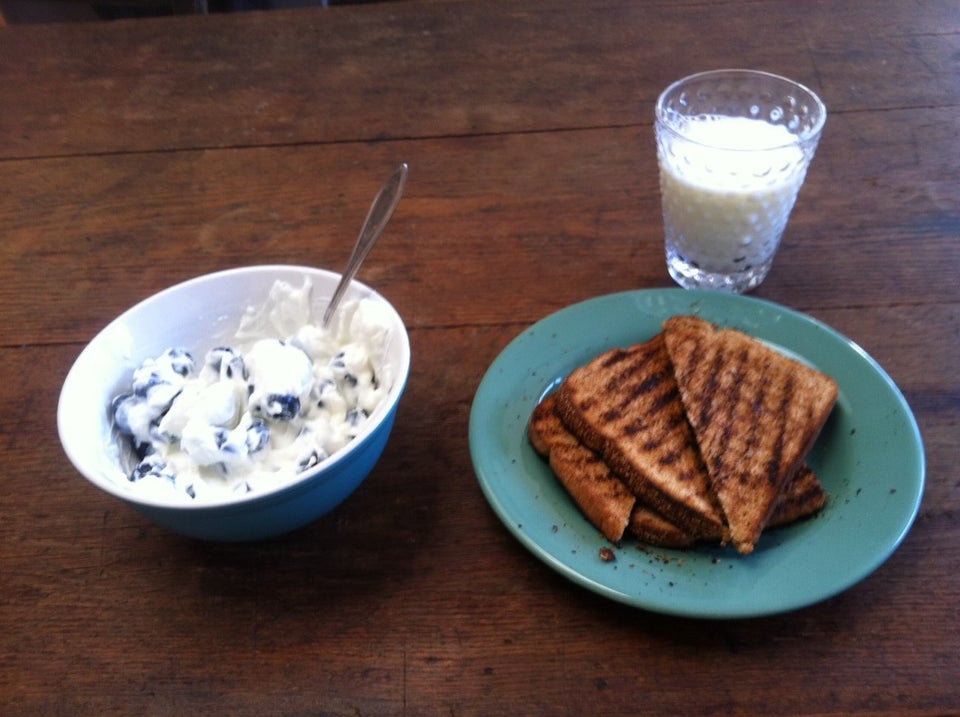The American diet, as a whole, changes at a glacial pace. Most individuals eat more or less the same thing, week in, week out, adding new staples and retiring old favorites only on very rare occasions. And zooming out to a scale of hundreds of millions, these individual shifts mostly cancel each other out. (One family might stop buying sour cream because they want to cut back on calories the same day that another family starts buying sour cream after tasting Paula Deen's recipe for spinach-artichoke dip.)
But of course, glaciers move -- their pace may be slow, but it's not stasis. Over the course of thousands of years, the movement of glaciers carved out the Great Lakes. And so it is with changes in the American diet. If you step back and look at progress over many years, you see real change.
That's the basic message of the latest installment of "The Changing American Diet," a series of reports by the Center for Science in the Public Interest which uses data from the U.S. Department of Agriculture to grade the healthfulness of U.S. eaters. This latest report card doesn't look so different from the recent ones issued by the CSPI. It's equally dismal, with an (unweighted) GPA of just 2.42.
The report shows that we eat slightly less caloric sweetener, whole milk and beef than we did in 2000 -- but also a fair bit more cheese and way more yogurt. We eat less shortening and a lot more oil. We eat more or less the same amount of calories, fruits, vegetables, fruit and seafood. All in all, then, we're eating about as much, and about as healthily, as we were a decade ago.
If you take a broader view, though, things start to look different. There's been real change in the composition of the American diet since 1970, the data point at which the CSPI graphs start -- and much of it is bad. Using the USDA source data for the CSPI report, we put together this animated GIF illustrating the changes over the past four decades in the number of calories that Americans get from each of the seven major food groups tracked by the USDA:
As you can see, the average American ate almost 500 more calories per day in 2010 than he or she did in 1970 -- a 23 percent increase. Fruit, vegetables, lean dairy and the meat, egg and nut category have all been virtually flat in that time. So almost the entire increase is due to growth in the top three categories on that GIF: basically, sugars, fats and carbs.
Specifically, Bonnie Liebman, the author of the CSPI report, attributed the bulk of that increase to two things: cheese and flour.
"We see this steady rise in cheese since 1970 that shows no signs of slowing down," she told The Huffington Post. "It's no longer just the cheese sandwich -- it's cheese in soup, cheese in salads, cheese on pizza, cheese in pizza crusts..."
"The change that has gotten less attention is the increase in flour and grains," she continued. "Since the 1970s, we have upped our consumption of flour -- and I think many people aren't aware of that. We're not baking at home, but it's the bread, the pasta, the burritos, the paninis, the muffins -- all of those. We're getting more flour in all of those foods. The numbers are shocking."
Liebman admitted that the popularity of the Atkins and South Beach diets, plus lots of good press around whole grains, has curbed the rise of flour consumption in the new millennium, but it's still much higher than it was as recently as 1980. Liebman thinks that's mostly because restaurants have an economic incentive to serve large portions of cheap, carb-heavy foods. They always have, of course, but we dine out far more than we did in 1970 -- which both gives us more chances to eat big plates of pasta and makes us think we should serve ourselves larger portions of pasta at home.
"Most people have no idea how small the recommended levels of grains are," Liebman explained, "because what we see in restaurants is so gigantic."
Our 2024 Coverage Needs You
It's Another Trump-Biden Showdown — And We Need Your Help
The Future Of Democracy Is At Stake
Our 2024 Coverage Needs You
Your Loyalty Means The World To Us
As Americans head to the polls in 2024, the very future of our country is at stake. At HuffPost, we believe that a free press is critical to creating well-informed voters. That's why our journalism is free for everyone, even though other newsrooms retreat behind expensive paywalls.
Our journalists will continue to cover the twists and turns during this historic presidential election. With your help, we'll bring you hard-hitting investigations, well-researched analysis and timely takes you can't find elsewhere. Reporting in this current political climate is a responsibility we do not take lightly, and we thank you for your support.
Contribute as little as $2 to keep our news free for all.
Can't afford to donate? Support HuffPost by creating a free account and log in while you read.
The 2024 election is heating up, and women's rights, health care, voting rights, and the very future of democracy are all at stake. Donald Trump will face Joe Biden in the most consequential vote of our time. And HuffPost will be there, covering every twist and turn. America's future hangs in the balance. Would you consider contributing to support our journalism and keep it free for all during this critical season?
HuffPost believes news should be accessible to everyone, regardless of their ability to pay for it. We rely on readers like you to help fund our work. Any contribution you can make — even as little as $2 — goes directly toward supporting the impactful journalism that we will continue to produce this year. Thank you for being part of our story.
Can't afford to donate? Support HuffPost by creating a free account and log in while you read.
It's official: Donald Trump will face Joe Biden this fall in the presidential election. As we face the most consequential presidential election of our time, HuffPost is committed to bringing you up-to-date, accurate news about the 2024 race. While other outlets have retreated behind paywalls, you can trust our news will stay free.
But we can't do it without your help. Reader funding is one of the key ways we support our newsroom. Would you consider making a donation to help fund our news during this critical time? Your contributions are vital to supporting a free press.
Contribute as little as $2 to keep our journalism free and accessible to all.
Can't afford to donate? Support HuffPost by creating a free account and log in while you read.
As Americans head to the polls in 2024, the very future of our country is at stake. At HuffPost, we believe that a free press is critical to creating well-informed voters. That's why our journalism is free for everyone, even though other newsrooms retreat behind expensive paywalls.
Our journalists will continue to cover the twists and turns during this historic presidential election. With your help, we'll bring you hard-hitting investigations, well-researched analysis and timely takes you can't find elsewhere. Reporting in this current political climate is a responsibility we do not take lightly, and we thank you for your support.
Contribute as little as $2 to keep our news free for all.
Can't afford to donate? Support HuffPost by creating a free account and log in while you read.
Dear HuffPost Reader
Thank you for your past contribution to HuffPost. We are sincerely grateful for readers like you who help us ensure that we can keep our journalism free for everyone.
The stakes are high this year, and our 2024 coverage could use continued support. Would you consider becoming a regular HuffPost contributor?
Dear HuffPost Reader
Thank you for your past contribution to HuffPost. We are sincerely grateful for readers like you who help us ensure that we can keep our journalism free for everyone.
The stakes are high this year, and our 2024 coverage could use continued support. If circumstances have changed since you last contributed, we hope you'll consider contributing to HuffPost once more.
Already contributed? Log in to hide these messages.


